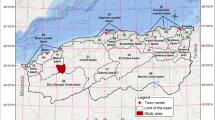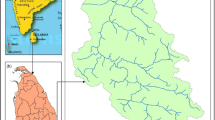Abstract
Whereas most studies addressing soil erosion have focused on determining the spatial distribution and extent of the problem, efforts to solve problems of erosion have remained limited. In response, a model for sustainable land use planning (SLUP) was used to improve the sustainable management of watersheds by preventing soil loss according to land use. The model was applied to a small-scale rural basin with forest, pasture and farmland at risk of soil erosion by integrating geographic information systems (GIS) and the universal soil loss equation (USLE) model. Initial mean soil loss in the basin was 4.9 t ha−1 yearly, most of which had occurred in the farmland. Although contour farming and strip cropping had reduced soil loss in the farmland by 19.5% and 59.4%, respectively, such methods failed to maintain the basin’s sustainability. However, with the model, soil loss decreased to 0.08 t ha−1 yearly. Thus, for the basin’s sustainable management, the land use planned there should be 88% forest, 10% pasture and 2% water surface. The results showed that the model for sustainable management can be used as a convenient tool for watershed management.







Similar content being viewed by others
References
Bathrellos, G.D., Skilodimou H.D. & Chousianitis K.G. (2010). Soil erosion assessment in southern Evia Island using USLE and GIS. Bulletin of the Geological Society of Greece. Proceedings of the 12th International Congress, Patras, May, (3), 1572.
Canga, M. R. (1995). Soil and water conservation. Ankara University, Publication of Agricultural Faculty: 1386, Lecture: 400, pp.118, Ankara (in Turkish).
Degirmencioglu, A., Mohtar, R.H., Daher, B.T., Ertugrul, G.O & Ertugrul, O. (2019). Assessing the sustainability of crop production in the Gediz basin, Turkey: A water, energy, and food nexus approach. Fresenius Environmental Bulletin, volume 28 – No. 4/2019, p. 2511-2522.
Delgado, A. & Gomez J. A. (2016). The soil physical, chemical and biological properties in: Principles of Agronomy for Sustainable Agriculture, p. 15-26, Editors: Villalobos, Francisco J., Fereres, Elias (Eds.).
Demczuk, P. (2009). Conform model USLE to automatic mapping intensity of soil erosion in the Bystrzanka Mountain catchment (Flysh Carpathian) (in Polish). In W. Bochenek & M. Kijowska (Eds.), The integrated monitoring of the environment (pp. 239–244). Szymbark: IGiPZ PAN.
Dedeoğlu, M. (2017). Sarayönü Beşgözlerler K.O.P. alanı detaylı toprak etüdü ve farklı yöntemlerle arazi değerlendirmesi (PhD Thesis). Selçuk University,Institute of Science, p.225. Konya, Turkey (in Turkish).
EEA, (2005). The European environment - state and outlook 2005. ISBN: 92–9167–776-0. (On-line: https://www.eea.europa.eu/publications/state_of_environment_report_2005_1).
Ekmekçi, E., Apan, M., & Kara, T. (2005). The effect of salinity on plant growth. Journal of the Faculty of Agriculture., OMU, 20(3), 118–125.
FAO. (2011). The state of the world’s land and water resources for food and agriculture (SOLAW) – managing systems at risk. London: Food and Agriculture Organization of the United Nations, Rome and Earthscan.
FAO. (2015). Status of the world’s soil resources (SWSR) – main report. Food and Agriculture Organization of the United Nations and Intergovernmental Technical Panel on Soils, Rome, Italy.
FAO. (2018). Handbook of saline soils management (Editors: R. Vargas, E.I. Pankova, S.A. Balyuk, P.V. Krasilnikov and G.M. Khasankhanova), Food and Agriculture Organization of the United Nations and Lomonosov Moscow State University. ISBN 978–92–5-130141-8 (FAO).
Ganasri, B. P., & Ramesh, H. (2016). Assessment of soil erosion by RUSLE model using remote sensing and GIS – a case study of Nethravathi Basin. Geoscience Frontiers, 7, 953–961.
Igwe, C. A., Akamigbo, F. O. R., & Mbagwu & J.S.C. (1999). Application of a SLEMSA and USLE erosion models for potential erosion hazard mapping in South-Eastern Nigeria. International Agrophysics, 13, 41–48.
Izakovicová, Z., Špulerová, J., & Petrovic, F. (2018). Integrated approach to sustainable land use management. Environments, 5, 37. https://doi.org/10.3390/environments5030037.
Jones, R.J.A. & Montanarella, L. (2003). Land degradation in Central and Eastern Europe. European Soil Bureau Research Report No.10, EUR 20688 EN, (2003), 324 pp. Office for Official Publications of the European Communities, Luxembourg.
Karas, E. (2005). Sustainable management of Küçükelmalı and Güvenç basins according water and sediment yield. PhD. Thesis. Ankara University, Graduate School of Natural and Applied Sciences, Department of Agricultural Structures and Irrigation, pp.236, Ankara.
Karas, E. (2008). Rainfall and runoff characteristics of Kurukavak creek basin. Soil and water resources institute of Eskisehir, p.82 (unpublished report), Eskisehir.
Karas, E., & Oğuz, I. (2015). A new approach to determine land use planning and soil conservation measures based on soil erosion classification. Carpathian Journal of Earth and Environmental Sciences, 10(2), 2015.
Kılıç, Ş. (2011). Agroecological land use potential of Amik plain, Turkey. Turkish Journal of Agriculture and Forestry, 35(4), 433–442.
Kılıç, S., Şenol, S., & Evrendilek, F. (2003). Evaluation of land use potential and suitability of ecosystems in Antakya for reforestation, recreation, arable farming and residence. Turkish Journal of Agriculture and Forestry, 27(1), 15–22.
Kılıç, Ş., Evrendilek, F., Şenol, S., & Çelik, İ. (2005). Developing a suitability index for land uses and agricultural land covers: A case study in Turkey. Environmental Monitoring and Assessment, 102(1–3), 323–335.
Machado, R. M. A., & Serralheiro, R. P. (2017). Soil salinity: Effect on vegetable crop growth. Management practices to prevent and mitigate soil salinization. Horticulturae, 3, 30. https://doi.org/10.3390/horticulturae3020030.
McCormack, D.E., Young, K.K. & Kimberlin, L.W. (1982). Current criteria for determining soil loss tolerance. Pages 95–111 in D. M. Kral (ed.), Determinants of soil loss tolerance. American Society of Agronomy Special Publication 45. Madison, Wisconsin.
Melesse, A. M., Ahmad, S., McClain, M. E., Wang, X., & Lim, Y. H. (2011). Suspended sediment load prediction of river systems: An artificial neural network approach. Agricultural Water Management, 98, 855–866.
Mohawesh, Y., Taimeh, A., & Ziadat, F. (2015). Effects of land use changes and soil conservation intervention on soil properties as indicators for land degradation under a Mediterranean climate. Solid Earth, 6, 857–868, www.solid-earth.net/6/857/2015/. https://doi.org/10.5194/se-6-857-2015.
Moore, I., & Burch, G. (1986). Physical basis of the length-slope factor in the universal soil loss equation. Soil Science Society of America Journal, 50, 1294–1298.
Nanok, J. K., & Onyango, C. O. (2017). A socio-economic and environmental analysis of the effects of oil exploration on the local community in Lokichar, Turkana County, Kenya. International Journal of Management, Economics and Social Sciences, 6(3), 144–156 ISSN 2304–1366.
Pacheco, F. A. L., Varandas, S. G. P., Fernandes, L. F., & Valle, J. R. F. (2014). Soil losses in rural watersheds with environmental land use conflicts. Science of the Total Environment, 485–486, 110–120.
Palom, A. R., Sauri, P. D., & Olcina, C. J. (2017). Sustainable land use planning in areas exposed to flooding: Some international experiences. In F. Vinet (Ed.), Floods, volume 2 risk management (pp. 103–117). Amsterdam: Elsevier Ltd.
Pimentel, D., & Burgess, M. (2013). Soil erosion threatens food production, Agriculture, MDPI. Open Access Journal, 3(3), 1–21.
Pretorius, J. R., & Cooks, J. (1989). Soil loss tolerance limits: An environmental management tool. GeoJournal, 19(1, Floodplain Environments (July 1989)), 67–75.
Senol, S. (1994). Computer-aided use of a model of agricultural land suitability classification Goksu Delta. Turkish Journal of Agriculture and Forestry, 18(5), 437–443.
Shadid, S.A., Zaman, M. & Heng, L. (2018). Soil salinity: Historical perspectives and a world overview of the problem. In: Guideline for Salinity Assessment, Mitigation and Adaptation Using Nuclear and Related Techniques. Springer, Cham. DOI: https://doi.org/10.1007/978-3-319-96190-32.
Sharma, A., Tiwari, K. N., & Bhadoria, P. B. S. (2011). Effect of land use land cover change on soil erosion potential in an agricultural watershed. Environmental Monitoring and Assessment March 2010. https://doi.org/10.1007/s10661-010-1423-6.
Soil Survey Staff, (1993). Soil survey manual. USDA Handbook. No: 18, Washington D.C. USA.
Stewart, B. A. (2016). Dryland farming. In: Reference Module in Food Science. https://doi.org/10.1016/B978-0-08-100596-5.02937-1.
Ştefanescu, L., Constantin, V., Surd, V., Ozunu, A., & Vlad, Ş. N. (2011). Assessment of soil erosion potential by the USLE method in Roşia montană mining area and associated natech events. Carpathian Journal of Earth And Environmental Sciences, 6(1), 35.
Turkseven, E. & Ayday, E. (2000). Application of USLE model on Bilecik-Kucukelmali basin and determination of its components. General directory of rural state affairs no. 117: 139-149. Ankara. (in Turkish).
UNDP. (2019). Combatting land degradation. Securing a sustainable future. The Global Environment Facility (GEF), The Government of Germany, the Green Climate Fund, Adaptation Fund, Lead Developed Country Fund (LDCF) and the Special Climate Change Fund (SCCF). United Nations Development Programme One United Nations Plaza New York, NY, 10017 USA.
Willy, D. K., Muyanga, M., Mbuvi, J., & Jayne, T. (2019). The effect of land use change on soil fertility parameters in densely populated areas of Kenya. Geoderma, 343, 254–262.
Wischmeier, W.H. & Smith, D.D. (1978). Predicting rainfall erosion losses. USDA agricultural handbook, no: 537, USA.
Yuksel, M. & Dengiz, O. (1996). Soil investigation report of Kucukelmali basin, pp.12 (unpublished report), Eskişehir. (in Turkish).
Author information
Authors and Affiliations
Corresponding author
Additional information
Publisher’s note
Springer Nature remains neutral with regard to jurisdictional claims in published maps and institutional affiliations.
Rights and permissions
About this article
Cite this article
Karas, E. Evaluation of a sustainable land use planning model in the Elmalı basin. Environ Monit Assess 192, 255 (2020). https://doi.org/10.1007/s10661-020-8203-8
Received:
Accepted:
Published:
DOI: https://doi.org/10.1007/s10661-020-8203-8




